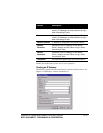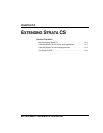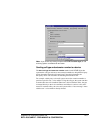
13-18 STRATA CS ADMINISTRATOR MANUAL
BETA DOCUMENT - PRELIMINARY & CONFIDENTIAL
n Dial any user’s extension directly, without an access code.
n See local users and remote users listed together in the Client’s Users view,
Place Call To dialog box, and all other places where a list of users appears.
n Select any user when placing a call, transferring a call or creating a
conference call.
n Search for any user in the dial-by-name directory.
n Forward calls to any extension, or include any extension in a routing list.
From the users’ perspective, IP Gateway users appear identical to local users (of
the type
User), except that IP Gateway users’ hook states do not appear in the
Client’s Users view.
By connecting two Servers over a private IP network and unifying them with IP
Gateway users, you can effectively double the number of stations your Strata CS
system supports.
Overview of IP Gateway users
An IP Gateway user is a special type of user that you create to mirror a user on
the remote Server. For each user on the remote Server, you create an IP Gateway
user on the local Server. For example, if the remote Server has a user named Pete
Storpin, you would create a user of the type
IP Gateway named Pete Storpin on
the local Server that points to the remote user.
The administrator on the remote Server performs the same action, creating an
IP
Gateway
user on the remote Server to mirror each User on your Server.
When a local user (of the type
User) dials an IP Gateway user’s extension, behind
the scenes the IP Gateway user automatically forwards the call over your Server’s
Internet-to-Centrex/PBX Extension dialing service to the matching user on the
remote Server.
Before creating IP Gateway users
To create an IP Gateway user, you must have already done the following on each
Server:
n Created an IP Gateway to point to the remote Server. See “Creating an IP
Gateway” on page 13-9.
n Created an Internet-to-Centrex/PBX Extension dialing service that
connects to the remote Server’s internal dial tone. See “Calling Strata CS
extensions on the remote Server” on page 13-13.
n Made sure that no extensions on one Server conflict with extensions on
the other. To avoid conflicts, you might have all the extensions on one
Server begin with 1, while all the extensions on the other Server begin
with 2.


















